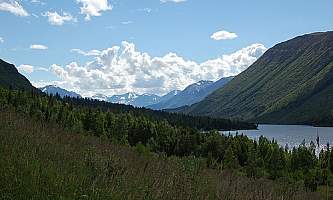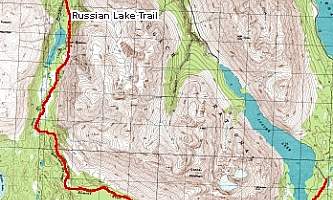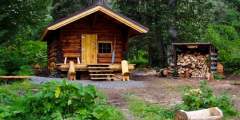Popular with hikers and backpackers—as well as bikers, birders, fishermen and hunters—this easy-to-follow trail connects the state’s most intense sockeye salmon sports fishery with stunning mountain backcountry. It offers many of the Kenai Peninsula’s highlights in one trip. After all, the 21-mile route accesses Russian River Falls, Lower and Upper Russian Lakes, Cooper Lake, 3 federally managed recreational cabins, and numerous campsites.
The trail also links to the region’s premier backpacking route, the 38-mile Resurrection Pass Trail that traverses north from the Russian River area through the mountains toward Hope. A through hike using both trails could create an epic, 60-mile adventure featuring historic gold rush areas, sweeping alpine tundra, legendary salmon fishing and a mountain lake paradise thick with wildlife.
Fish Photo Ops
The biggest draw in the summer may be the Russian River Falls and fish counting station, both good bets for salmon viewing. The Falls are 2 miles up a well-maintained and mostly flat gravel trail that is wheelchair accessible and an easy bike or ski. It starts at the Russian River Trailhead inside the Russian River Campground. At the falls, you can venture out onto decks that are partially suspended over the water, which makes for great photo of airborne fish. But that’s not all.
This striking riparian canyon can concentrate gobs of wildlife, including both brown and black bears feasting on salmon during the June-August runs. It’s a great place to look for birds, too, including American dippers, harlequin ducks and bohemian waxwings. The setting can be a stunning, exciting place to visit.
Another quarter mile or so brings you to the fish-counting weir at the outflow of Lower Russian Lake, another great place to watch the green-headed, red-bodied salmon persevere in their journey toward spawning grounds.
Bear viewing
Bears do target salmon at the falls. But they are common throughout the drainage, wherever and whenever the fish concentrate. The Russian River angler’s trail—running along the river below the campground bluff from the mouth at the Kenai River upstream to the falls—may be one of the best places on the Alaska road system to see brown and black bears in their natural setting. Several well-marked stairways provide access from parking lots and campsite areas down to the river corridor.
When fish are running, scores of anglers might be working the clear water with single-hook flies. Non-fishing visitors should recognize that they could come face-to-face with a bear anywhere on the trail or the riverside path. As a result, they should use sound bear-country practices at all times—make noise, travel in a group, never leave food items or backpacks on the ground and carry bear spray for deterrence.
If any bears are present, give them plenty of space (at least 100 yards) and be prepared to yield them the river (and any fish) while backing away in an orderly fashion with your group. Carry binoculars and long camera lenses so you are never tempted to approach too closely.
Planning your trip up the Russian Lakes Trail
First, you will need to prep for a backcountry wilderness journey with suitable clothing, food and gear for the season and duration. Check out our clothing, hiking, backpacking and skiing guides, as well as our primer on Alaska weather. While there are plentiful sources of water along the route, it should be purified before drinking.
In general, Alaska backpacking requires carrying a wider range of clothing than you might pack for a summer adventure in a more southern locale. Alaska’s summer climate swings from chilly rain to hot sunshine, and higher elevations can see wintry temperatures or even snow in any month. On a July outing through the Kenai Mountains, however, you should expect temps to range from the 40s-50s at night to 60s or 70s in the day. Always be prepared for rain or foul conditions, but the Kenai Mountains can experience stretches of dry, sunny weather during summer.
When should you go?
People usually traverse the whole 21-mile route only during summer and fall, with best backpacking and biking found late June through snowfall. Winter travel can be difficult between Lower and Upper Russian lakes, with exposure to avalanche hazard, though skiing is often good between the campground area and Berber Cabin on Lower Russian Lake. In general, the first three miles to Lower Russian Lake draws many visitors during salmon fishing season between June and August. Hunting parties travel the trail in fall, concentrating in the backcountry above Upper Russian Lake.
Give yourself three to four days.
With 20-plus hours of usable daylight near summer solstice, people do power through in two long days, or even less. But if you’re backpacking the full route one-way for fun and adventure, consider taking a three-to-four day trip that allows you to divide the journey into roughly two segments of 8 to 11 miles each and one rest day. (Mountain bikers may travel faster, depending on fitness or conditions.)
With enough time, you would have the option to camp two nights on one of the lakes and spend a full day exploring, fishing or just enjoying the scene. Adding extra time also makes the shuttle easier. Driving from Anchorage or another town, dropping off a shuttle car and then returning to your starting trailhead can easily eat half a day or more. And that’s before you start hiking!
Cabins or campsites?
You have two options for accommodations on multi-day trips: rent one of three cabins or carry a tent. If you want to rent one of these cabins—or a succession of cabins for night-after-night stays—you must book well ahead of time. Cabins during the main hiking, fishing and hunting seasons between May 1 and Sept. 30 are usually taken as soon as they become available, beginning six months in advance of the arrival date. Often to the day. Check with Reserve America by searching on cabin names.
Campsites are available on a first-come basis and there is almost always space to accommodate late arrivals. But there’s no guarantee you won’t find your first choice sweet spot already occupied or crowded during good weather in the middle of summer fishing season or over a holiday weekend. In that event, you may camp in the forest or tundra using no-trace camping practices. People are asked to camp at least 300 feet from any cabin reserved by other travelers.
Start north or east?
Starting at the north trailhead (Lower Russian) in the campground may be simpler because it gets the front country congestion out of the way on the first day. There can be a line of cars waiting to get into the Russian River Campground, and lots of traffic. A north start also brings you more quickly to prime wildlife viewing and lake fishing areas. On the other hand, the east trailhead (Upper Russian or Cooper Lake) offers a different experience with a more remote atmosphere. You immediately enter a quiet backcountry realm in wooded country above 1,000 feet in elevation. Most of the route toward the north trailhead is downhill.
Need to set up a shuttle?
If you want to hike from one end to the other, you need to set up a shuttle. The road distance between the two trailheads is less than 18 miles, so it’s not that time consuming to drop off one vehicle at your exit and return in a second vehicle to your starting trailhead.
Do the shuttle yourself
With two vehicles, the shuttle can be easy. If starting the trip at the Russian River Campground, for instance, first drop the exit vehicle at the east trailhead in the mountains near Cooper Lake. To get there, turn onto Snug Harbor Road at Mile 48 of the Sterling Highway (south side of Kenai Lake), drive 9 miles to Cooper Lake Road, and then climb 3 miles further to parking at the trailhead. Then drive the second vehicle to the north trailhead, one mile into the Russian River Campground at Mile 52.6 of the Sterling Highway. Check in at the ranger kiosk for a free parking pass.
Trailhead and access notes: Snug Harbor Road can be icy, and Cooper Lake Road is not plowed in winter.
Call Wildman’s for a taxi or shuttle. The easiest solution for out-of-state visitors or parties with a single vehicle may be to book a ride! The folks at the Wildman’s store at Mile 47.5 of the Sterling Highway offer a shuttle or taxi service to and from either trailhead for a group rate of $125 per hour. (They also offer drop-offs and pick-ups for Kenai River boaters and transportation to and from other area trails.) Depending upon the amount of gear, the taxi can transport up to six or seven backpackers between the east and north trailheads. Call 907-595-1456 to figure out what makes sense for your particular itinerary and its cost, and make a reservation.
Connect to other trail systems
You can link the Russian Lakes Trail to two other trail systems to create much longer trips. If you can handle a very challenging backcountry segment that receives little maintenance and are willing to do some highway walking, it’s possible to trek more than 90 miles through the Kenai Mountains without retracing your steps.
- Resurrection Pass Trail. This very popular 38-mile trail traverses the Kenai Mountains between the Russian River area and Hope on Turnagain Arm. It’s only about 1.5 miles on foot from the Russian Lakes north trailhead inside the campground to the Resurrection Pass south trailhead at Mile 53.2 of the Sterling Highway. For ideas and details about two other trail links on this system, see our connecting trails page.
- Resurrection River Trail. For those seeking a rugged experience that includes route finding and stream crossings, the Resurrection River Trail continues south from the Russian Lakes Trail about 15 miles out. Not often used by through hikers, this 16-mile route follows the Resurrection River valley to Exit Glacier Road near Seward.
Trail Highlights: Easy Access and Camping
From the Falls, the trail continues along eastern shore of Lower Russian Lake to Barber Public Use Cabin and a campsite equipped with a bear-resistant locker. The lake itself is closed to salmon fishing, but is a popular destination for those seeking rainbow trout. Expect a cosmopolitan experience in this area during summer salmon season! The first 3 miles from the trailhead to the upper end of the lake are very popular and experience heavy use, especially when the sockeye runs are peaking in mid June and mid-July.
From Lower Russian Lake, the trail circles south and then east another 18 miles before climbing to its exit at Cooper Lake recreation area. The highlight of the trip may be the much larger Upper Russian Lake, with good rainbow trout fishing and a stunning view of mountains. Plus two more public use cabins and six campsites.
The route is striking for its wildlife and geography. A mature spruce-birch lowland—with many stands of beetle-killed spruce—reaches toward west into rugged wilderness that receives few visitors. To the east looms the massive Cooper Mountain, rising 2,000 to 3,500 feet above the trail.
In the fall, the upper area hosts quite a few hunting parties with pack animals, so be aware of the possibility for added traffic and offer the right-of-way, especially if you’re biking.
Fishing and boating
The legendary Russian River below the falls is the most popular salmon sports fishery in the state and a destination for serious fly fishing anglers in pursuit of big rainbows. Above the falls, salmon fishing is off limits.
• The Russian River drainage above the falls, including both Lower and Upper Russian lakes, can provide fabulous rainbow trout fishing. Anglers catch Dolly Varden too.
• Rowboats with oars are available to people who have rented the cabins on Lower and Upper Russian Lakes. Others must work the shore or carry a lightweight raft.
• Be sure to check the latest Alaska fishing regulations for updates or restrictions before you go.
A few other things to keep in mind
- You will be off the grid. The trail traverses a mountain valley that grows more remote and less visited the further you get from the Russian River Campground. Though busy at times, especially during salmon season, the trip still requires all the same preparations and skills that you would bring to any other multi-day adventure into wilderness. Plan on being self-sufficient. Assume you will NOT be able to phone out for help.
- It’s bear country. The Russian Lakes Trail and river corridor is prime brown bear country. So take all the usual precautions—including storing food in bear lockers or portable vaults, keeping a clean camp and carrying bear spray for deterrence. Make noise and pay attention. Hikers regularly report encounters with or see bears.
- The Forest Service adds this message: Safety is your responsibility. Be prepared. Let someone know where and when you will return and follow Leave No Trace outdoor ethics along the way.
- Shop before you leave town. Once you leave Anchorage or other towns like Seward or Soldotna for the mountains, there are no specialized camping retailers or large grocery stores along the route. To be sure, the Cooper Landing area features restaurants, guide services, small stores and museums well worth visiting. But you should plan on leaving town with your trip’s staples and essential gear already in hand.
- Seasonal concerns. Travel between Lower Russian Lake and Upper Russian Lake can be difficult during snow season, and snow can remain on the route well into June. Several avalanche hazards are present. No motorized travel is allowed between the north trailhead and Upper Russian Lake, but is allowed between east trailhead and Upper Russian Lake between Nov. 30 and May 1. Saddle and pack stock are not allowed on the trail between April 1 and June 30.
For more information:
For current conditions contact the Seward Ranger District, 33599 Ranger Station Spur (mile marker 23.5), Seward, AK 99664. (907) 288-3178
For online trail profiles:
For fact sheets, maps and GPS coordinates:
Russian Lakes Trail fact sheet and map (PDF)
Resurrection Pass south fact sheet and map (PDF)
Resurrection Pass north fact sheet and map (PDF)
Resurrection River Trail fact sheet and map (PDF)
Fishing and wildlife links
Russian River fishing and recreation details
Wildlife viewing at Russian River Falls






